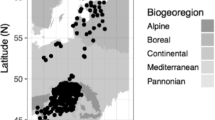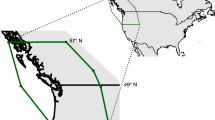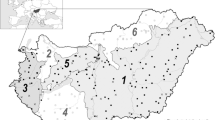Abstract
Global surface temperature has increased markedly over the last 100 years. This increase has a variety of implications for human societies, and for ecological systems. One of the most obvious ways ecosystems are affected by global climate change is through alteration of organisms’ developmental timing (phenology). We used annual botanical surveys that documented the first flowering for an array of species from 1976 to 2003 to examine the potential implications of climate change for plant development. The overall trend for these species was a progressively earlier flowering time. The two earliest flowering taxa (Galanthus and Crocus) also exhibited the strongest shift in first flowering. We detected a significant trend in climate suggesting higher temperatures in winter and spring over the sampling interval and found a significant relationship between warming temperatures and first flowering time for some species. Although 60% of the species in our study flowered earlier over the sampling interval, the remaining species exhibited no statistically detectable change. This variation in response is ostensibly associated with among-species variation in the role of climate cues in plant development. Future work is needed to isolate specific climate cues, and to link plant phenology to the physiological processes that trigger plant development.




Similar content being viewed by others
References
Abu-Asab MS, Peterson PM, Shetler SG, Orli SS (2001) Earlier plant flowering in spring as a response to global warming in the Washington, DC, area. Biodivers Conserv 10:597–612
Houghton JT et al (eds) (2001) Climate Change 2001: the scientific basis. Contribution of working group I to the third assessment report of the Intergovernmental Panel on Climate Change. Cambridge University Press, Cambridge
Bradley NL, Leopold AC, Ross J, Huffaker W (1999) Phenological changes reflect climate change in Wisconsin. Proc Natl Acad Sci USA 96:9701–9704
Chapin FS, Randerson JT, McGuire AD, Foley JA, Field CB (2008) Changing feedbacks in the climate-biosphere system. Front Ecol Environ 6:313–320
Fitter AH, Fitter RSR (2002) Rapid changes in flowering time in British plants. Science 296:1689–1691
Houle G (2007) Spring-flowering herbaceous plant species of the deciduous forests of eastern Canada and 20th century climate warming. Can J For Res 37:505–512
Iverson LR, Prasad A (1998) Predicting abundance of 80 tree species following climate change in the eastern United States. Ecol Monogr 68:465–485
Menzel A et al (2006) European phenological response to climate change matches the warming pattern. Global Change Biol 12:1969–1976
Muller RN (1978) The phenology, growth and ecosystem dynamics of Erythronium americanum in the northern hardwood forest. Ecol Monogr 48:1–20
Nordli Ø, Wielgolaski FE, Bakken AK, Hjeltnes SH, Måge F, Sivle A, Skre O (2008) Regional trends for bud burst and flowering of woody plants in Norway as related to climate change. Int J Biometeorol 52:625–639
Orlandi F, Ruga L, Romano B, Fornaciari M (2005) Olive flowering as an indicator of local climatic changes. Theor Appl Climatol 81:169–176
Parmesan C (2006) Ecological and evolutionary responses to recent climate change. Annu Rev Ecol Evol Syst 37:637–669
Parmesan C, Yohe G (2003) A globally coherent fingerprint of climate change impacts across natural systems. Nature 421:37–42
Parry ML, Canziani OF, Palutikof JP, van der Linden PJ, Hanson CE (eds) (2007) Climate change 2007: impacts, adaptation and vulnerability. Contribution of working group II to the fourth assessment report of the Intergovernmental Panel on Climate Change. Cambridge University Press, Cambridge
Primack D, Imbres C, Primack RB, Miller-Rushing AJ, Tredici PD (2004) Herbarium specimens demonstrate earlier flowering times in response to warming in Boston. Am J Bot 91:1260–1264
Solomon S, Qin D, Manning M, Chen Z, Marquis M, Averyt KB, Tignor M, Miller HL (eds) (2007) Climate change 2007: the physical science basis. Contribution of working group I to the fourth assessment report of the Intergovernmental Panel on climate change. Cambridge University Press, Cambridge
Walther GR, Post E, Convey P, Menzel A, Parmesan C, Beebee TJC, Fromentin JM, Hoegh-Gulberg O, Bairlein F (2002) Ecological responses to recent climate change. Nature 416:389–395
Woodall CW, Oswalt CM, Westfall JA, Perry CH, Nelson MD, Finley AO (2009) An indicator of tree migration in forests of the eastern United States. For Ecol Manag 257:1434–1444
Acknowledgments
This analysis was made possible by three decades of careful observations by Carol Graff. We are appreciative of her careful botanical efforts and grateful that she was willing to share her data. Comments by Amy L. Goff-Yates and two anonymous reviewers greatly improved this manuscript.
Author information
Authors and Affiliations
Corresponding author
Rights and permissions
About this article
Cite this article
McEwan, R.W., Brecha, R.J., Geiger, D.R. et al. Flowering phenology change and climate warming in southwestern Ohio. Plant Ecol 212, 55–61 (2011). https://doi.org/10.1007/s11258-010-9801-2
Received:
Accepted:
Published:
Issue Date:
DOI: https://doi.org/10.1007/s11258-010-9801-2




